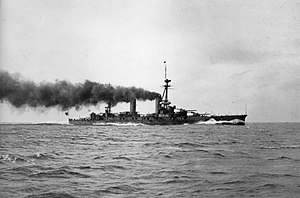Fusō-class battleship

Yamashiro on her trials, 19 December 1916
|
|
| Class overview | |
|---|---|
| Name: | Fusō class |
| Builders: | |
| Operators: |
|
| Preceded by: | Kawachi class |
| Succeeded by: | Ise class |
| Built: | 1912–1917 |
| In service: | 1915–1944 |
| In commission: | 1915–1944 |
| Completed: | 2 |
| Lost: | 2 |
| General characteristics (as built) | |
| Type: | Dreadnought battleship |
| Displacement: | 29,330 long tons (29,800 t) (standard) |
| Length: | 202.7 m (665 ft 0 in) |
| Beam: | 28.7 m (94 ft 2 in) |
| Draft: | 8.7 m (28 ft 7 in) |
| Installed power: |
|
| Propulsion: |
|
| Speed: | 23 knots (43 km/h; 26 mph) |
| Range: | 8,000 nmi (15,000 km; 9,200 mi) at 14 knots (26 km/h; 16 mph) |
| Complement: | 1,193 |
| Armament: |
|
| Armor: |
|
| General characteristics (1944) | |
| Displacement: | 34,700 long tons (35,300 t) |
| Length: | 210.3 m (690 ft 0 in) |
| Beam: | 33.1 m (108 ft 7 in) |
| Installed power: |
|
| Propulsion: | 4 × steam turbines |
| Speed: | 24.5 knots (45.4 km/h; 28.2 mph) |
| Range: | 11,800 nmi (21,900 km; 13,600 mi) at 16 knots (30 km/h; 18 mph) |
| Complement: | 1,900 |
| Sensors and processing systems: |
|
| Armament: |
|
| Armor: | Deck: 152–51 mm (6–2 in) |
| Aircraft carried: | 3 × floatplanes |
| Aviation facilities: | 1 × catapult |
The Fusō-class battleships (扶桑型戦艦 Fusō-gata senkan?) were a pair of dreadnought battleships built for the Imperial Japanese Navy (IJN) during World War I. Both patrolled briefly off the coast of China before being placed in reserve at the war's end. In 1922, Yamashiro became the first battleship in the IJN to successfully launch aircraft.
During the 1930s, both ships underwent a series of modernizations and reconstructions. Fusō underwent her modernization in two phases (1930–33, 1937–41), while Yamashiro was reconstructed from 1930 to 1935. The modernization increased their armor, replaced and upgraded their machinery, and rebuilt their superstructures into the distinctive pagoda mast style. Despite the expensive reconstructions, both vessels were considered obsolescent by the eve of World War II, and neither saw significant action in the early years of the war. Fusō served as a troop transport in 1943, while Yamashiro was relegated to training duty in the Inland Sea. Both underwent upgrades to their anti-aircraft suite in 1944 before transferring to Singapore in August 1944.
Fusō and Yamashiro were the only two Japanese battleships at the Battle of Surigao Strait, the southernmost action of the Battle of Leyte Gulf, and both were lost in the early hours of 25 October 1944 to torpedoes and naval gunfire. Some eyewitnesses later claimed that Fusō broke in half, and that both halves remained afloat and burning for an hour, but historian Anthony Tully has made the case that she simply sank after forty minutes of flooding. Six battleships and eight cruisers were lying in wait for Yamashiro; she did not survive the encounter, and Vice-Admiral Shōji Nishimura went down with his ship. Only ten crewmembers from each ship survived.
...
Wikipedia
